Indexed in: ESCI, Scopus, PubMed,
PubMed Central, CAS, DOAJ, KCI
PubMed Central, CAS, DOAJ, KCI
FREE article processing charge

Previous issues
- Page Path
- HOME > Browse Articles > Previous issues
Imagery
- “Another color of the world”
- J Yeungnam Med Sci. 2022;39(2):i. Published online February 24, 2022
- DOI: https://doi.org/10.12701/jyms.2022.00136

- 2,563 View
- 73 Download
Review articles
- Current diagnosis and treatment of vestibular neuritis: a narrative review
- Chang Hoon Bae, Hyung Gyun Na, Yoon Seok Choi
- J Yeungnam Med Sci. 2022;39(2):81-88. Published online August 9, 2021
- DOI: https://doi.org/10.12701/yujm.2021.01228

- 65,535 View
- 505 Download
- 9 Web of Science
- 13 Crossref
-
 Abstract
Abstract
 PDF
PDF - Vertigo is the sensation of self-motion of the head or body when no self-motion is occurring or the sensation of distorted self-motion during an otherwise normal head movement. Representative peripheral vertigo disorders include benign paroxysmal positional vertigo, Ménière disease, and vestibular neuritis. Vestibular neuritis, also known as vestibular neuronitis, is the third most common peripheral vestibular disorder after benign paroxysmal positional vertigo and Ménière disease. The cause of vestibular neuritis remains unclear. However, a viral infection of the vestibular nerve or ischemia of the anterior vestibular artery is known to cause vestibular neuritis. In addition, recent studies on immune-mediated mechanisms as the cause of vestibular neuritis have been reported. The characteristic clinical features of vestibular neuritis are abrupt true-whirling vertigo lasting for more than 24 hours, and no presence of cochlear symptoms and other neurological symptoms and signs. To accurately diagnose vestibular neuritis, various diagnostic tests such as the head impulse test, bithermal caloric test, and vestibular-evoked myogenic potential test are conducted. Various treatments for vestibular neuritis have been reported, which are largely divided into symptomatic therapy, specific drug therapy, and vestibular rehabilitation therapy. Symptomatic therapies include generalized supportive care and administration of vestibular suppressants and antiemetics. Specific drug therapies include steroid therapy, antiviral therapy, and vasodilator therapy. Vestibular rehabilitation therapies include generalized vestibular and customized vestibular exercises.
-
Citations
Citations to this article as recorded by- Vestibular function is associated with immune inflammatory response
Zhaohui Song, Yuchuan Ding, Nathan Sim, Ho Jun Yun, Jing Feng, Pan Gu, Xiaokun Geng
Reviews in the Neurosciences.2024; 35(3): 293. CrossRef - Prevalence of Scarpa’s ganglion enhancement on high-resolution MRI imaging
Clayton Siminski, John C Benson, Matthew L Carlson, John I Lane
The Neuroradiology Journal.2024; 37(3): 332. CrossRef - Vestibular rehabilitation for peripheral vestibular hypofunction: an interdisciplinary consensus
N.L. Kunelskay, G.E. Ivanova, E.V. Baybakova, A.L. Guseva, V.A. Parfenov, M.V. Zamergrad, O.V. Zaitseva, O.A. Melnikov, A.A. Shmonin, M.N. Maltseva
Vestnik otorinolaringologii.2024; 89(1): 52. CrossRef - A Review of Calcitonin Gene-Related Peptide and Its Implications for Vestibular Disorders
Richard Baron, Kristen K. Steenerson
Current Treatment Options in Neurology.2024; 26(6): 203. CrossRef - Evolution of Hyperventilation-Induced Nystagmus in Acute Unilateral Vestibulopathy—Interpretative Model and Etiopathogenetic Hypotheses
Francesco Frati, Alessandra D’Orazio, Valeria Gambacorta, Giacomo Ciacca, Giampietro Ricci, Mario Faralli
Audiology Research.2024; 14(3): 442. CrossRef - Evaluating the impact of COVID-19 on vertigo and hearing impairment: A post-recovery analysis
Sarah Alshehri, Khalid A. Alahmari
Medicine.2024; 103(27): e38819. CrossRef - Vertigo in the Setting of COVID-19 Infection: A Case Report
Sanjana Devaragudi, Mohit Gupta
Cureus.2023;[Epub] CrossRef - Hospital Admission Profile Related to Inner Ear Diseases in England and Wales
Esra’ O. Taybeh, Abdallah Y. Naser
Healthcare.2023; 11(10): 1457. CrossRef - Symptom of vertigo and dizziness in patients with COVID-19
E. V. Isakova
Russian neurological journal.2023; 28(4): 5. CrossRef - VESTIBULAR NEURONITIS: A CLINICAL EXAMPLE OF THE COURSE OF THE DISEASE USING BIOFEEDBACK (BOS)
Geraskina M.M., Razzhivina K.S., Ustinov S.A.
"Medical & pharmaceutical journal "Pulse".2023; : 30. CrossRef - Acute vestibular neuritis: A rare complication after the adenoviral vector-based COVID-19 vaccine
Hamze Shahali, Ramin Hamidi Farahani, Parham Hazrati, Ebrahim Hazrati
Journal of NeuroVirology.2022; 28(4-6): 609. CrossRef - A Holistic Approach to a Dizzy Patient: A Practical Update
Ioannis Koukoulithras, Gianna Drousia, Spyridon Kolokotsios, Minas Plexousakis, Alexandra Stamouli, Charis Roussos, Eleana Xanthi
Cureus.2022;[Epub] CrossRef - Identification of hub genes and pathophysiological mechanism related to acute unilateral vestibulopathy by integrated bioinformatics analysis
Yajing Cheng, Jianrong Zheng, Ying Zhan, Cong Liu, Bihua Lu, Jun Hu
Frontiers in Neurology.2022;[Epub] CrossRef
- Vestibular function is associated with immune inflammatory response
- Coronavirus disease 2019 (COVID-19) vaccine platforms: how novel platforms can prepare us for future pandemics: a narrative review
- Jae Kyung Lee, Ok Sarah Shin
- J Yeungnam Med Sci. 2022;39(2):89-97. Published online February 14, 2022
- DOI: https://doi.org/10.12701/jyms.2021.01669

- 3,373 View
- 73 Download
- 1 Web of Science
- 1 Crossref
-
 Abstract
Abstract
 PDF
PDF - More than 2 years after the explosion of the coronavirus disease 2019 (COVID-19) pandemic, extensive efforts have been made to develop safe and efficacious vaccines against infections with severe acute respiratory syndrome coronavirus 2. The pandemic has opened a new era of vaccine development based on next-generation platforms, including messenger RNA (mRNA)-based technologies, and paved the way for the future of mRNA-based therapeutics to provide protection against a wide range of infectious diseases. Multiple vaccines have been developed at an unprecedented pace to protect against COVID-19 worldwide. However, important knowledge gaps remain to be addressed, especially in terms of how vaccines induce immunogenicity and efficacy in those who are elderly. Here, we discuss the various vaccine platforms that have been utilized to combat COVID-19 and emphasize how these platforms can be a powerful tool to react quickly to future pandemics.
-
Citations
Citations to this article as recorded by- Preclinical evaluation of immunogenicity, efficacy and safety of a recombinant plant-based SARS-CoV-2 RBD vaccine formulated with 3M-052-Alum adjuvant
Waranyoo Phoolcharoen, Balamurugan Shanmugaraj, Narach Khorattanakulchai, Piyanate Sunyakumthorn, Sathit Pichyangkul, Pornnarin Taepavarapruk, Wanlapa Praserthsee, Suchinda Malaivijitnond, Suwimon Manopwisedjaroen, Arunee Thitithanyanont, Kanjana Srisutth
Vaccine.2023; 41(17): 2781. CrossRef
- Preclinical evaluation of immunogenicity, efficacy and safety of a recombinant plant-based SARS-CoV-2 RBD vaccine formulated with 3M-052-Alum adjuvant
Original articles
- Storing information of stroke rehabilitation patients using blockchain technology: a software study
- Min Cheol Chang
- J Yeungnam Med Sci. 2022;39(2):98-107. Published online September 7, 2021
- DOI: https://doi.org/10.12701/yujm.2021.01368
- 5,050 View
- 85 Download
- 2 Web of Science
- 2 Crossref
-
 Abstract
Abstract
 PDF
PDF - Background
Stroke patients usually experience damage to multiple functions and a long rehabilitation period. Hence, there is a large volume of patient clinical information. It thus takes a long time for clinicians to identify the patient’s information and essential pieces of information may be overlooked. To solve this, we stored the essential clinical information of stroke patients in a blockchain and implemented the blockchain technology using the Java programming language.
Methods
We created a mini blockchain to store the medical information of patients using the Java programming language.
Results
After generating a unique pair of public/private keys for identity verification, a patient’s identity is verified by applying the Elliptic Curve Digital Signature Algorithm based on the generated keys. When the identity verification is complete, new medical data are stored in the transaction list and the generated transaction is verified. When verification is completed normally, the block hash value is derived using the transaction value and the hash value of the previous block. The hash value of the previous block is then stored in the generated block to interconnect the blocks.
Conclusion
We demonstrated that blockchain can be used to store and deliver the patient information of stroke patients. It may be difficult to directly implement the code that we developed in the medical field, but it can serve as a starting point for the creation of a blockchain system to be used in the field. -
Citations
Citations to this article as recorded by- Prediction of motor outcome based on brain perfusion single photon emission computed tomography in corona radiata infarct
Eunjung Kong, Donghwi Park, Min Cheol Chang
International Journal of Neuroscience.2023; : 1. CrossRef - Use of QR Codes for Promoting a Home-Based Therapeutic Exercise in Patients with Lumbar Disc Herniation and Lumbar Spinal Stenosis: A Prospective Randomized Study
Min Cheol Chang, Donghwi Park, Yoo Jin Choo
Journal of Pain Research.2022; Volume 15: 4065. CrossRef
- Prediction of motor outcome based on brain perfusion single photon emission computed tomography in corona radiata infarct
- Clinical performance of FractionLab in patient-specific quality assurance for intensity-modulated radiotherapy: a retrospective study
- Se An Oh, Sung Yeop Kim, Jaehyeon Park, Jae Won Park, Ji Woon Yea
- J Yeungnam Med Sci. 2022;39(2):108-115. Published online September 9, 2021
- DOI: https://doi.org/10.12701/yujm.2021.01123

- 4,673 View
- 87 Download
-
 Abstract
Abstract
 PDF
PDF - Background
This study was aimed at comparing and analyzing the results of FractionLab (Varian/Mobius Medical System) with those of portal dosimetry that uses an electronic portal imaging device. Portal dosimetry is extensively used for patient-specific quality assurance (QA) in intensity-modulated radiotherapy (IMRT).
Methods
The study includes 29 patients who underwent IMRT on a Novalis-Tx linear accelerator (Varian Medical System and BrainLAB) between June 2019 and March 2021. We analyzed the multileaf collimator (MLC) DynaLog files generated after portal dosimetry to evaluate the same condition using FractionLab. The results of the recently launched FractionLab at various gamma indices (0.1%/0.1 mm–1%/1 mm) are analyzed and compared with those of portal dosimetry (3%/3 mm).
Results
The average gamma passing rates of portal dosimetry (3%/3 mm) and FractionLab are 98.1 (95.5%–100%) and 97.5% (92.3%–99.7%) at 0.6%/0.6 mm, respectively. The results of portal dosimetry (3%/3 mm) are statistically comparable with the QA results of FractionLab (0.6%/0.6 mm–0.9%/0.9 mm).
Conclusion
This paper presents the clinical performance of FractionLab by the comparison of the QA results of FractionLab using portal dosimetry with various gamma indexes when performing patient-specific QA in IMRT treatment. Further, the appropriate gamma index when performing patient-specific QA with FractionLab is provided.
- User perception of medical service robots in hospital wards: a cross-sectional study
- Jung Hwan Lee, Jae Meen Lee, Jaehyun Hwang, Joo Young Park, Mijeong Kim, Dong Hwan Kim, Jae Il Lee, Kyoung Hyup Nam, In Ho Han
- J Yeungnam Med Sci. 2022;39(2):116-123. Published online October 5, 2021
- DOI: https://doi.org/10.12701/yujm.2021.01319
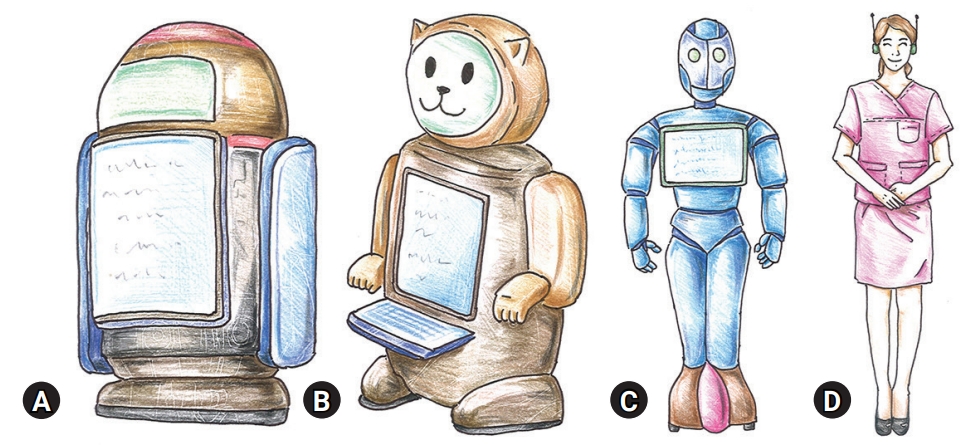
- 4,797 View
- 106 Download
- 3 Web of Science
- 3 Crossref
-
 Abstract
Abstract
 PDF
PDF - Background
Recently, there have been various developments in medical service robots (MSRs). However, few studies have examined the perceptions of those who use it. The purpose of this study is to identify user perceptions of MSRs.
Methods
We conducted a survey of 320 patients, doctors, and nurses. The contents of the survey were organized as follows: external appearances, perceptions, expected utilization, possible safety accidents, and awareness of their responsibilities. Statistical analyses were performed using t-test, chi-square test, and analysis of variance.
Results
The most preferred appearance was the animal type, with a screen. The overall average score of positive questions was 3.64±0.98 of 5 points and that of negative questions was 3.24±0.99. Thus, the results revealed that the participants had positive perceptions of MSR. The overall average of all expected utilization was 4.05±0.84. The most expected utilization was to guide hospital facilities. The most worrisome accident was exposure to personal information. Moreover, participants thought that the overall responsibility of the robot user (hospital) was greater than that of the robot manufacturer in the case of safety accidents.
Conclusion
The perceptions of MSRs used in hospital wards were positive, and the overall expected utilization was high. It is necessary to recognize safety accidents for such robots, and sufficient attention is required when developing and manufacturing robots. -
Citations
Citations to this article as recorded by- Robotic Anesthesia: A Vision for 2050
Thomas M. Hemmerling, Sean D. Jeffries
Anesthesia & Analgesia.2024; 138(2): 239. CrossRef - Exploring the influence of anthropomorphic appearance on usage intention on online medical service robots (OMSRs): A neurophysiological study
Yi Ding, Ran Guo, Muhammad Bilal, Vincent G. Duffy
Heliyon.2024; 10(5): e26582. CrossRef - Customer acceptance of service robots under different service settings
Yi Li, Chongli Wang, Bo Song
Journal of Service Theory and Practice.2023; 33(1): 46. CrossRef
- Robotic Anesthesia: A Vision for 2050
- The clinical outcomes of second-line chemotherapy in patients with advanced pancreatic cancer: a retrospective study
- Hyun yeb Jung, Eun Mi Lee
- J Yeungnam Med Sci. 2022;39(2):124-132. Published online October 19, 2021
- DOI: https://doi.org/10.12701/yujm.2021.01347

- 4,553 View
- 95 Download
- 2 Web of Science
- 2 Crossref
-
 Abstract
Abstract
 PDF
PDF - Background
Despite recent advances in first-line chemotherapy for advanced pancreatic cancer, standard treatment after the failure of initial chemotherapy has not been established. Hence, we aimed to retrospectively analyze the clinical characteristics and outcomes of second-line chemotherapy in patients with advanced pancreatic cancer.
Methods
We reviewed the clinical data of patients with advanced pancreatic cancer who underwent palliative chemotherapy at Kosin University Gospel Hospital between January 2013 and October 2020.
Results
Among 366 patients with advanced pancreatic cancer who had received palliative chemotherapy, 104 (28.4%) underwent at least one cycle of second-line chemotherapy. The median age of the patients at the time of initiating second-line treatment was 62 years (interquartile range, 57–62 years), and 58.7% (61 patients) of them were male. The common second-line chemotherapy regimens were 5-fluorouracil (FU) plus leucovorin, irinotecan, and oxaliplatin (33 patients, 31.7%); gemcitabine/nab-paclitaxel (29, 27.9%), gemcitabine±erlotinib (13, 12.5%); and oxaliplatin and 5-FU/leucovorin (12, 11.5%). The median overall survival (OS) and progression-free survival were 6.4 months (95% confidence interval [CI], 4.5–8.6 months) and 4.5 months (95% CI, 2.7–6.3 months), respectively. In a multivariate analysis, poor performance status (PS) (hazard ratio [HR], 2.247; p=0.021), metastatic disease (HR, 2.745; p=0.011), and elevated carcinoembryonic antigen (CEA) levels (HR, 1.939; p=0.030) at the beginning of second-line chemotherapy were associated with poor OS.
Conclusion
The survival outcome of second-line chemotherapy for advanced pancreatic cancer remains poor. However, PS, disease extent (locally advanced or metastatic), and CEA level may help determine patients who could benefit from second-line treatment. -
Citations
Citations to this article as recorded by- Efficacy and tolerance of LV5FU2-carboplatin chemotherapy in patients with advanced pancreatic ductal adenocarcinoma after failure of standard regimens
Thomas Chaigneau, Lina Aguilera Munoz, Caroline Oger, Clémence Gourdeau, Olivia Hentic, Lucie Laurent, Nelly Muller, Marco Dioguardi Burgio, Marie-Pauline Gagaille, Philippe Lévy, Vinciane Rebours, Pascal Hammel, Louis de Mestier
Therapeutic Advances in Medical Oncology.2023; 15: 175883592311637. CrossRef - Real-Life Results of Palliative Chemotherapy in Metastatic Pancreatic Ductal Adenocarcinoma
Bianca Varzaru, Razvan A. Iacob, Adina E. Croitoru, Speranta M. Iacob, Cristina E. Radu, Stefania M. Dumitrescu, Cristian Gheorghe
Cancers.2023; 15(13): 3500. CrossRef
- Efficacy and tolerance of LV5FU2-carboplatin chemotherapy in patients with advanced pancreatic ductal adenocarcinoma after failure of standard regimens
- Patient outcomes and prognostic factors associated with colonic perforation surgery: a retrospective study
- Do-bin Lee, Seonhui Shin, Chun-Seok Yang
- J Yeungnam Med Sci. 2022;39(2):133-140. Published online October 29, 2021
- DOI: https://doi.org/10.12701/yujm.2021.01445
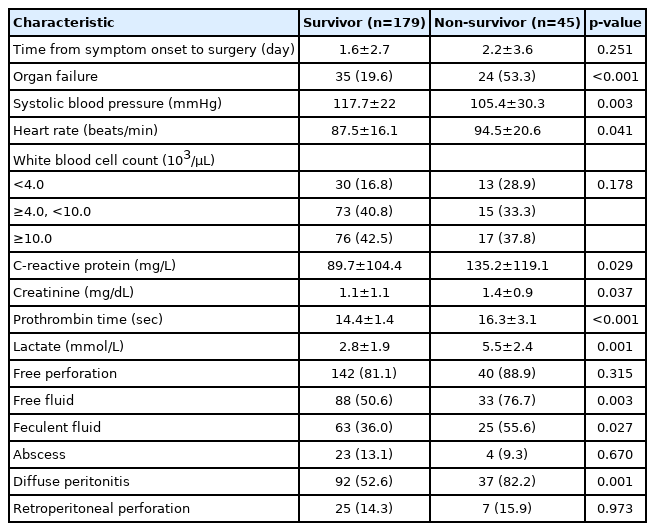
- 4,229 View
- 114 Download
- 2 Web of Science
- 3 Crossref
-
 Abstract
Abstract
 PDF
PDF - Background
Despite advances in surgery and intensive perioperative care, fecal peritonitis secondary to colonic perforation is associated with high rates of morbidity and mortality. This study was performed to review the outcomes of patients who underwent colonic perforation surgery and to evaluate the prognostic factors associated with mortality.
Methods
A retrospective analysis was performed on 224 consecutive patients who underwent emergency colonic perforation surgery between January 2008 and May 2019. We divided the patients into survivor and non-survivor groups and compared their surgical outcomes.
Results
The most common cause of colon perforation was malignancy in 54 patients (24.1%), followed by iatrogenic perforation in 41 (18.3%), stercoral perforation in 39 (17.4%), and diverticulitis in 37 (16.5%). The sigmoid colon (n=124, 55.4%) was the most common location of perforation, followed by the ascending colon, rectum, and cecum. Forty-five patients (20.1%) died within 1 month after surgery. Comparing the 179 survivors with the 45 non-survivors, the patient characteristics associated with mortality were advanced age, low systolic blood pressure, tachycardia, organ failure, high C-reactive protein, high creatinine, prolonged prothrombin time, and high lactate level. The presence of free or feculent fluid, diffuse peritonitis, and right-sided perforation were associated with mortality. In multivariate analysis, advanced age, organ failure, right-sided perforation, and diffuse peritonitis independently predicted mortality within 1 month after surgery.
Conclusion
Age and organ failure were prognostic factors for mortality associated with colon perforation. Furthermore, right-sided perforation and diffuse peritonitis demonstrated a significant association with patient mortality. -
Citations
Citations to this article as recorded by- Colorectal Oncologic Emergencies
Joshua Sullivan, Alec Donohue, Shaun Brown
Surgical Clinics of North America.2024; 104(3): 631. CrossRef - One Year of Experience Managing Peritonitis Secondary to Gastrointestinal Perforation at a Tertiary Care Hospital: A Retrospective Analysis
Muhammad Hasaan Shahid, Faisal I Khan, Zain Askri, Arslan Asad, M. Azhar Alam, Danish Ali, Rabia Saeed, Aun Jamal, Tauseef Fatima, M. Farooq Afzal
Cureus.2022;[Epub] CrossRef - Risk factors for urgent complications of colorectal cancer
S. N. Shchaeva
Pelvic Surgery and Oncology.2022; 12(2): 28. CrossRef
- Colorectal Oncologic Emergencies
- Clinical implication of adjuvant chemotherapy according to mismatch repair status in patients with intermediate-risk stage II colon cancer: a retrospective study
- Byung Woog Kang, Dong Won Baek, Eunhye Chang, Hye Jin Kim, Su Yeon Park, Jun Seok Park, Gyu Seog Choi, Jin Ho Baek, Jong Gwang Kim
- J Yeungnam Med Sci. 2022;39(2):141-149. Published online December 22, 2021
- DOI: https://doi.org/10.12701/yujm.2021.01571

- 3,970 View
- 95 Download
- 1 Web of Science
- 2 Crossref
-
 Abstract
Abstract
 PDF
PDF - Background
The present study evaluated the clinical implications of adjuvant chemotherapy according to the mismatch repair (MMR) status and clinicopathologic features of patients with intermediate- and high-risk stage II colon cancer (CC).
Methods
This study retrospectively reviewed 5,774 patients who were diagnosed with CC and underwent curative surgical resection at Kyungpook National University Chilgok Hospital. The patients were enrolled according to the following criteria: (1) pathologically diagnosed with primary CC; (2) stage II CC classified based on the 7th edition of the American Joint Committee on Cancer staging system; (3) intermediate- and high-risk features; and (4) available test results for MMR status. A total of 286 patients met these criteria and were included in the study.
Results
Among the 286 patients, 54 (18.9%) were identified as microsatellite instability-high (MSI-H) or deficient MMR (dMMR). Although all the patients identified as MSI-H/dMMR showed better survival outcomes, T4 tumors and adjuvant chemotherapy were identified as independent prognostic factors for survival. For the intermediate-risk patients identified as MSI-low (MSI-L)/microsatellite stable (MSS) or proficient MMR (pMMR), adjuvant chemotherapy exhibited a significantly better disease-free survival (DFS) but had no impact on overall survival (OS). Oxaliplatin-containing regimens showed no association with DFS or OS. Adjuvant chemotherapy was not associated with DFS in intermediate-risk patients identified as MSI-H/dMMR.
Conclusion
The current study found that the use of adjuvant chemotherapy was correlated with better DFS in MSI-L/MSS or pMMR intermediate-risk stage II CC patients. -
Citations
Citations to this article as recorded by- Behavioral and Neuroanatomical Consequences of Cell-Type Specific Loss of Dopamine D2 Receptors in the Mouse Cerebral Cortex
Gloria S. Lee, Devon L. Graham, Brenda L. Noble, Taylor S. Trammell, Deirdre M. McCarthy, Lisa R. Anderson, Marcelo Rubinstein, Pradeep G. Bhide, Gregg D. Stanwood
Frontiers in Behavioral Neuroscience.2022;[Epub] CrossRef - A pilot retrospective study of comprehensive nursing care on psychological disorder in colorectal cancer undergoing chemotherapy
Zhou-Yi Zhang, Rui Wang, Li Zhang, Ming-Li Gu, Xiu-E Guan
Medicine.2022; 101(28): e29707. CrossRef
- Behavioral and Neuroanatomical Consequences of Cell-Type Specific Loss of Dopamine D2 Receptors in the Mouse Cerebral Cortex
Case reports
- Twin anemia polycythemia sequence in a dichorionic diamniotic pregnancy: a case report
- Soo-Young Lee, Jin Young Bae, Seong Yeon Hong
- J Yeungnam Med Sci. 2022;39(2):150-152. Published online July 2, 2021
- DOI: https://doi.org/10.12701/yujm.2021.01060
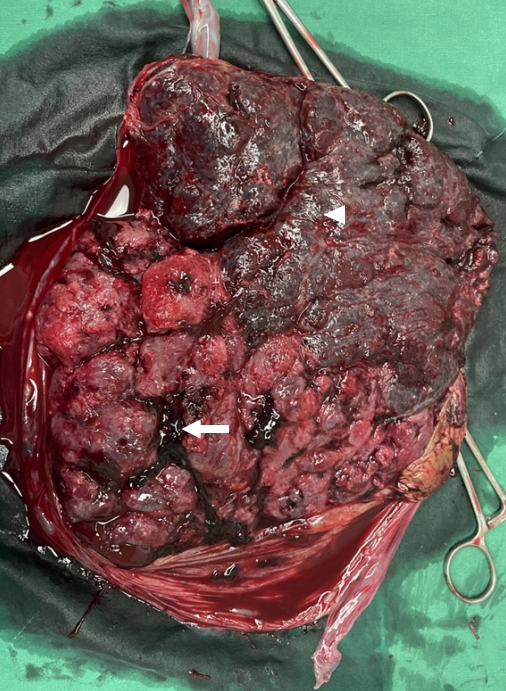
- 5,178 View
- 86 Download
- 1 Crossref
-
 Abstract
Abstract
 PDF
PDF - Complications related to the vascular anastomosis of the placental vessels in monochorionic twins are fatal. The clinical syndromes of feto-fetal transfusion include twin anemia polycythemia sequence (TAPS), twin-twin transfusion syndrome, and twin reversed arterial perfusion sequence. We present an extremely rare case of TAPS in a dichorionic diamniotic pregnancy. A 36-year-old woman, gravida 0, para 0, was referred to our hospital with suspected preterm premature membrane rupture. Although her pelvic examination did not reveal specific findings, the non-stress test result showed minimal variability in the first fetus and late deceleration in the second one. An emergency cesarean section was performed. The placenta was fused, and one portion of the placenta was pale, while the other portion was dark red. The hemoglobin level of the first fetus was 7.8 g/dL and that of the second one was 22.2 g/dL.
-
Citations
Citations to this article as recorded by- Suspected twin anemia polycythemia sequence in a dichorionic, diamniotic twin pregnancy: a case report
Tania Jeyaseelan, Panicos Shangaris, Athina Efthymiou, Linzi Martin, Lisa Story, Surabhi Nanda, Neelam Gupta, Mudher Al-Adnani, Andreas Marnerides, Kypros H. Nicolaides, Srividhya Sankaran
Journal of Medical Case Reports.2023;[Epub] CrossRef
- Suspected twin anemia polycythemia sequence in a dichorionic, diamniotic twin pregnancy: a case report
- Idiopathic multicentric Castleman disease presenting progressive reticular honeycomb infiltration of lung and immunoglobulin G and immunoglobulin G4 dominant hypergammaglobulinemia: a case report
- Hyun-Je Kim, Young-Hoon Hong
- J Yeungnam Med Sci. 2022;39(2):153-160. Published online July 5, 2021
- DOI: https://doi.org/10.12701/yujm.2021.01039
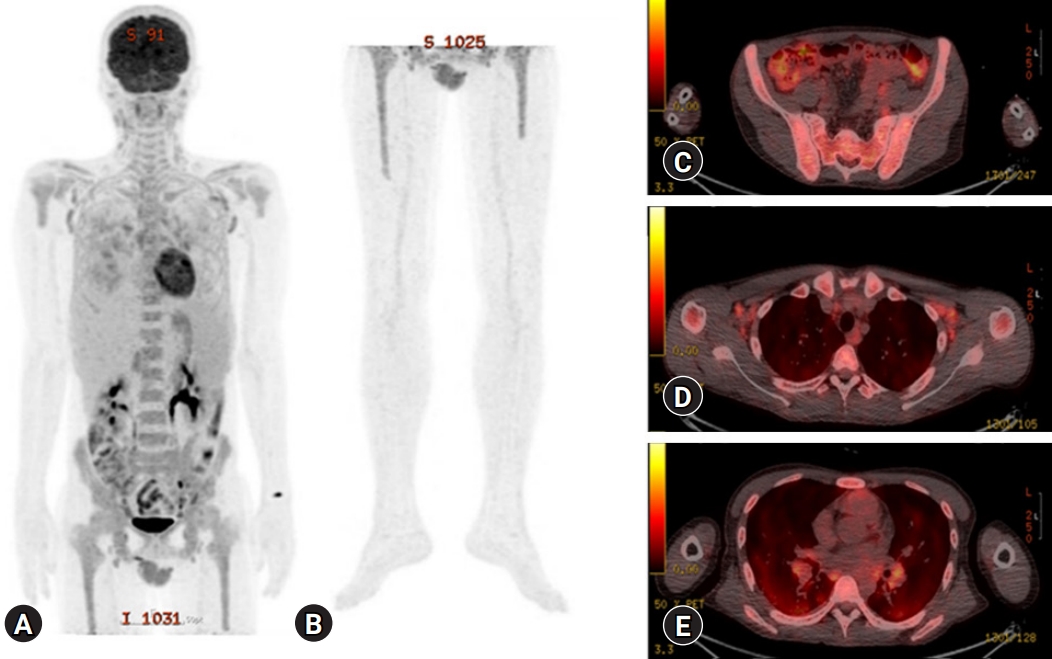
- 4,965 View
- 90 Download
-
 Abstract
Abstract
 PDF
PDF - Multicentric Castleman disease (MCD) is an uncommon systemic lymphoproliferative disorder that may cause multiple organ damage. Castleman disease-associated diffuse parenchymal lung disease (DPLD) has not been well studied. A 32-year-old man was referred to our hospital for progressive generalized weakness, light-headedness, and dyspnea on exertion for more than one year. Laboratory evaluations showed profound anemia, an elevated erythrocyte sedimentation rate, and an increased C-reactive protein level with polyclonal hypergammaglobulinemia. Chest radiography, computed tomography (CT), and positron emission tomography-CT scan demonstrated diffuse lung infiltration with multiple cystic lesions and multiple lymphadenopathy. In addition to these clinical laboratory findings, bone marrow, lung, and lymph node biopsies confirmed the diagnosis of idiopathic MCD (iMCD). Siltuximab, an interleukin-6 inhibitor, and glucocorticoid therapy were initiated. The patient has been tolerating the treatment well and had no disease progression or any complications in 4 years. Herein, we report this case of human herpesvirus-8-negative iMCD-associated DPLD accompanied by multiple cystic lesions, multiple lymphadenopathy, and polyclonal hypergammaglobulinemia with elevated immunoglobulin G (IgG) and IgG4 levels. We recommend a close evaluation of MCD in cases of DPLD with hypergammaglobulinemia.
- Congenital web of the common bile duct combined with multiple intrahepatic duct stricture: a case report of successful radiological intervention
- Hanseul Lim, Shin Hwang, Gi-Young Ko, Hyejin Han
- J Yeungnam Med Sci. 2022;39(2):161-167. Published online July 8, 2021
- DOI: https://doi.org/10.12701/yujm.2021.01179

- 4,694 View
- 55 Download
-
 Abstract
Abstract
 PDF
PDF - Congenital web formations are extremely rare anomalies of the extrahepatic biliary tree. We herein report a case of common bile duct septum combined with multiple intrahepatic bile duct strictures in a 74‐year‐old female patient who was successfully treated with radiological intervention. The patient initially visited the hospital because of upper abdominal pain. Imaging studies revealed multifocal strictures with dilatation in both intra- and extrahepatic ducts; the final clinical diagnosis was congenital common bile duct web combined with multiple intrahepatic duct strictures. Surgical treatment was not indicated because multiple biliary strictures were untreatable, and the disease was clinically diagnosed as benign. The multiple strictures were extensively dilated twice through bilateral percutaneous transhepatic biliary drainage (PTBD) for 2 months. After 1 month of observation, PTBD catheters were successfully removed. The patient is doing well at 6 months after completion of the radiological intervention, with the maintenance of normal liver function. Congenital web of the bile duct is very rare, and its treatment may vary depending on the patterns of biliary stenosis. In cases where surgical intervention is not indicated for congenital web and its associated disease, radiological intervention with balloon dilatation can be a viable therapeutic option.
- Palisaded encapsulated neuroma on the lower lip: a case report
- Jung Eun Seol, Seong Min Hong, Sang Woo Ahn, Jong Uk Kim, Woo Jung Jin, So Hee Park, Hyojin Kim
- J Yeungnam Med Sci. 2022;39(2):168-171. Published online July 9, 2021
- DOI: https://doi.org/10.12701/yujm.2021.01088

- 5,429 View
- 81 Download
-
 Abstract
Abstract
 PDF
PDF - Palisading encapsulated neuroma is a rare, benign, cutaneous nerve sheath tumor. It usually occurs as an asymptomatic solitary skin-colored papule and commonly affects the nose and cheeks. Sometimes, it involves other sites, including the shoulder, upper arm, and trunk, but rarely involves the oral mucosa, including that of the lip. In our case, a 63-year-old female patient complained of a pinkish rubbery nodule on her lower lip. Histopathologic examination demonstrated a well-circumscribed nodule encapsulated by connective tissue stroma in the dermis. The nodule consisted of palisading spindle-shaped tumor cells with wavy and basophilic nuclei. The cells were arranged in streaming fascicles with multiple clefts and were strongly positive for S-100 proteins. To our knowledge, only three cases of palisading encapsulated neuroma on the lower lip have been reported in the Korean literature. Herein, we report a rare case of an oral palisaded encapsulated neuroma.
- Reverse Takotsubo cardiomyopathy with left bundle branch block after anesthesia induction in a patient with subarachnoid hemorrhage: a case report
- Eun Kyung Choi, Jong-Hoon Kim, Minhyun Kim
- J Yeungnam Med Sci. 2022;39(2):172-178. Published online October 25, 2021
- DOI: https://doi.org/10.12701/yujm.2021.01354
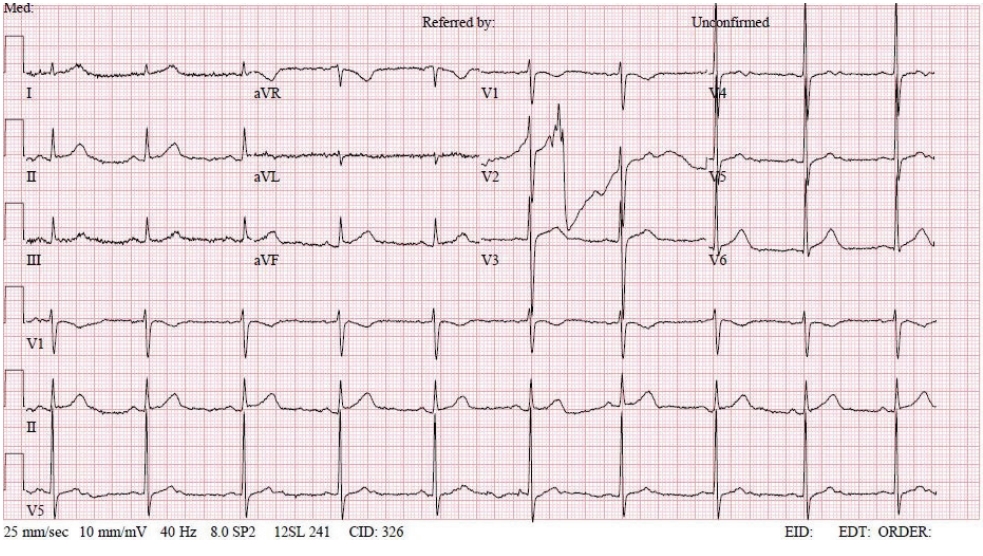
- 4,516 View
- 78 Download
- 1 Web of Science
-
 Abstract
Abstract
 PDF
PDF - Cardiac dysfunction after subarachnoid hemorrhage (SAH) is described as Takotsubo or reverse Takotsubo cardiomyopathy that shows transient left ventricular wall motion abnormalities with electrocardiogram (ECG) changes. ST change followed by T inversion is a common ECG finding complicated with these disorders, left bundle branch block (LBBB) may be a potential ECG pattern which is seen. In this case, we describe the clinical profile and outcomes of a patient with LBBB and reverse Takotsubo cardiomyopathy after anesthetic induction, which was scheduled as an emergent external ventricular drainage after SAH. This is the first report of an LBBB pattern in reverse Takotsubo cardiomyopathy.

 E-Submission
E-Submission Yeungnam University College of Medicine
Yeungnam University College of Medicine


 First
First Prev
Prev



